Your Cart is Empty
camera packages
housings
Arms and trays
Accessories
OM SYSTEM TG-7 UNDERWATER SET-UP
October 31, 2023 6 min read
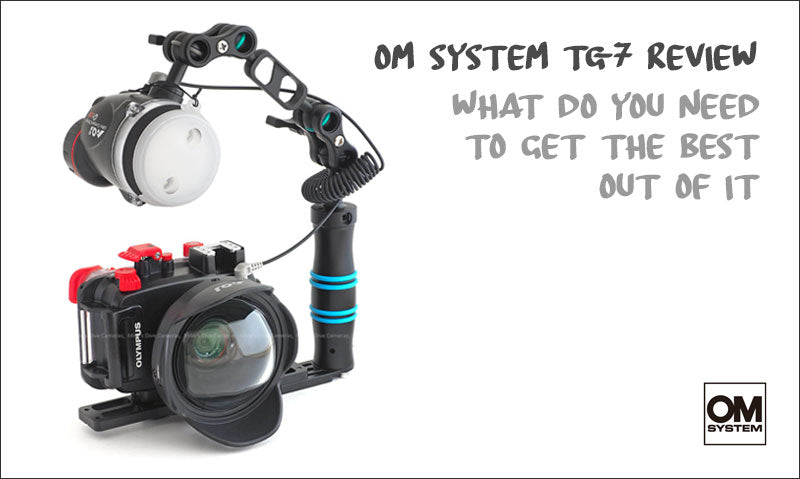
The OM System TG-7 Tough camera is finally available! Initially, I intended to write a traditional review of it, but as it is almost identical to the previous Olympus-made model, I decided to talk about what a diver needs to add to this camera to really make it work well underwater. Below, I talk about lenses, strobes and other small bits that help you take your underwater photography to the next level with this smart little camera.
OM Systems TG-7 Tough

In 2020, the traditional Japanese optics and camera manufacturer Olympus decided to sell their whole camera department and essentially stop developing any new products. A new company called OMDS bought the lot and has since released a few exciting cameras under the name OM System. The last ever Olympus Tough camera, the TG-6, was released already in 2019. Now the OM System TG-7 has replaced this, and it comes with… well… no new features to mention. The most significant change is the logo on the camera body.
This might sound like a damp squib, but as the compact camera market gets smaller and smaller, the TG-7, even without any new features to mention, is still a unique product and "top of its own range". The OM System TG-7 Tough still has the brilliant microscope mode for easy underwater macro. The camera body is waterproofed to 12m, which means that if a bit of water gets inside the PT-059 underwater housing, the camera is likely to survive. The housing itself is still the same Olympus-made case that worked with the previous TG-5 and 6 cameras. Again, there really was no need to update anything, as the PT-059 is an excellent case with big buttons, 52mm port thread, accessory shoe and a screen shade.
External lenses? Yes
The TG-7 and the PT-059 combo works well for macro shots thanks to the unique "microscope" mode. Although most compact cameras have close-up/macro modes allowing to focus relatively close, they only work when the lens is at its widest setting. With the TG-7 (and the previous models), the close focus distance stays super close even when zoomed in to the full 100mm tele position. This means that unlike with almost any other underwater camera package, you do not have to get an external close-up dioptre lens for the TG-7.

How about wide-angle, then? The OM System TG-7 lens is 25mm at its widest position, which means about a 70-degree (diagonal) angle of view. Inside the PT-059 housing, in water, this angle is narrowed to about 50mm due to the refraction. Simply put, wide-angle shots are not possible without adding a lens. Luckily, there are a few good choices available.
The most basic wet-interchangeable lenses available for the PT-059 housing are more like corrective eyeglasses than super wide-angle lenses. These domed units typically claw back some of the lost angle and sharpen the corners. These lenses are sometimes called "air-lenses" as they negate the water's disrupting effects. An example of this kind of lens is the Weefine WFL11 M52.
But as water is an unforgiving element to take photos in, a much wider lens is often needed. The two most popular we sell are the Weefine WFL-02 and the AOI UWL-400A. The WFL12 is slightly larger and has a wide-angle view of 140 degrees. The smaller and handier AOI lens still offers a respectable 120-degree angle. Both lenses screw on the PT-059 52mm port and can be removed in water. The AOI also offers an additional quick-release bayonet system for the UWL-400A, which makes changing lenses in water straightforward.
Lights? Yes.
Although the TG-7 lens works well for macro/micro shots, the same can't be said for the internal strobe. The onboard flash is situated so near the lens that when it fires, the results are unimpressive and flat. Also, any particles in water will be illuminated and reflected straight back to the camera lens. To get the best out of this camera package, an external underwater strobe is needed. An off-camera strobe positioned away from the lens axis with the help of a simple arm system will result in more natural looking, dynamic photos.
There are plenty of lights out there, but in this text, I will talk about two small and reasonably affordable units: the AOI-Q1 RC and the Backscatter MF-2. These are also the most compatible strobes for the TG-7.
AOI Ultra Compact UCS-Q1 RC Strobe
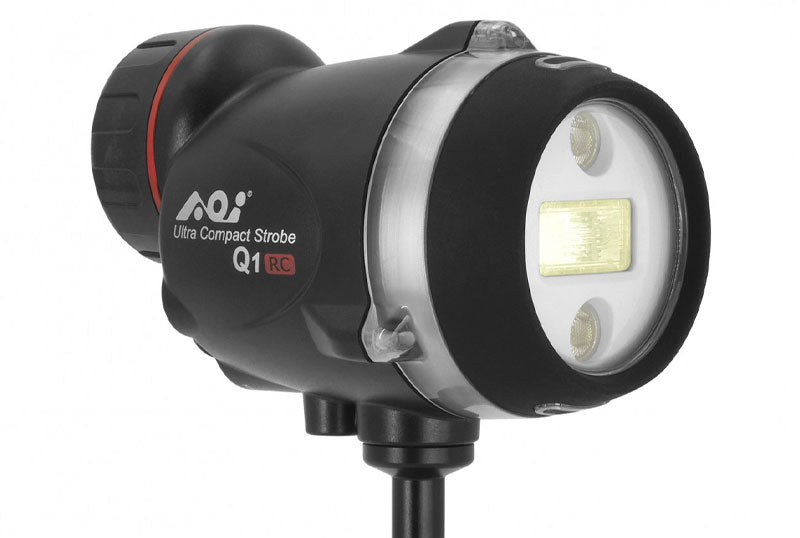
The affordable AOI UCS-Q1 comes in two versions. The basic Q1 and a Q1 RC. For any Olympus / OM System user, the clear choice is the RC version, which works with the relatively little-known but rather ingenious Olympus RC "wireless" flash control protocol. With the RC mode turned on in the camera, an external strobe can be controlled by the onboard flash via super-fast pulses of light. The RC system is not a new thing anymore, and Olympus even made underwater strobes that used this system. The issue with the RC system is that it was never designed for close-up and macro photography. The previous Olympus underwater flashes, like the UFL-2, had to be turned to a manual setting for macro photography as the RC mode resulted in overexposures.
AOI has been working with Olympus for years (for example, they used to make the Olympus housings), and they have now introduced a new automatic i-macro mode for their Q1 RC strobe. This mode corrects the overexposure issue, and finally, the RC mode can be used for all sorts of underwater shots, including macro. The AOI UQS-Q1 RC strobe is a diminutive unit weighing only 500 grams but still comes with a respectable output with a guide no 22. The Q1 strobes use rechargeable 18650 Li-ion batteries, which allow the strobe to be used for days without worrying about a battery change. A bright 700-lumen focus light is also included.
Backscatter MF-2 Strobe
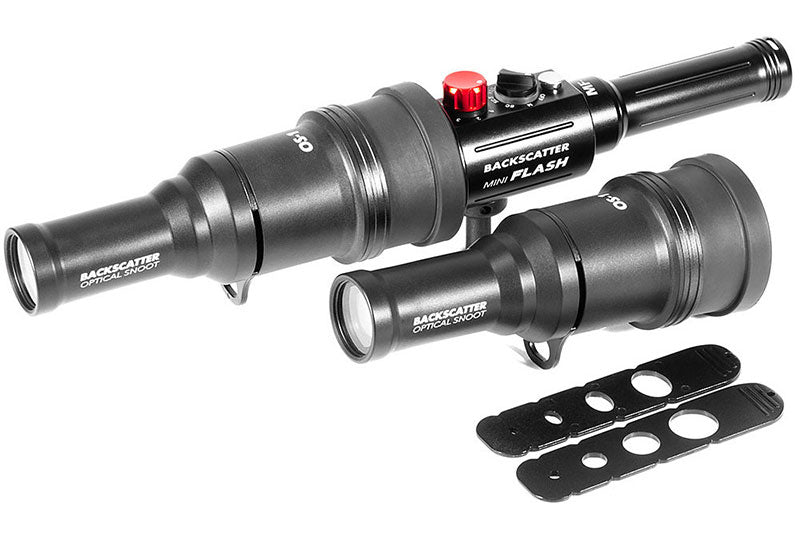
The MF-2, or Mini Flash 2, is a super compact aluminium-bodied strobe designed for macro shooters. It comes with an unbelievable amount of features traditional underwater flash makers can only dream of. It is by far the most advanced underwater strobe on the market currently. The secret is that the MF-2, like almost all Backscatter branded products, is also made by AOI. The same RC-controlled automatic modes are also available on this strobe, although this time around, they are called the SC and SC macro. On top of this, the Mini Flash 2 can be used as a remote control of another MF-2, making off-camera lighting easier than it has ever been. The strobe also supports high-speed sync (HSS) that allows shooting with extremely fast shutter speeds and large apertures without losing control of the background exposure.
The most striking feature of the Backscatter MF-2 is, of course, the OS-1 snoot. Although you can get the strobe on its own, 99% of the people buy it as a package with the snoot. The OS-1 snoot is the most precise and easy-to-use compact snoot available and works seamlessly with the Mini Flash 2. The 1000-lumen spotting light can be used through the snoot and makes the aiming super easy. The OS-1 is not just an empty tube but also contains lenses that gather the light without losing power. Special aperture sticks that ship with the unit can be used to further control the shape and diameter of the beam. It truly is a macro photographer's dream!
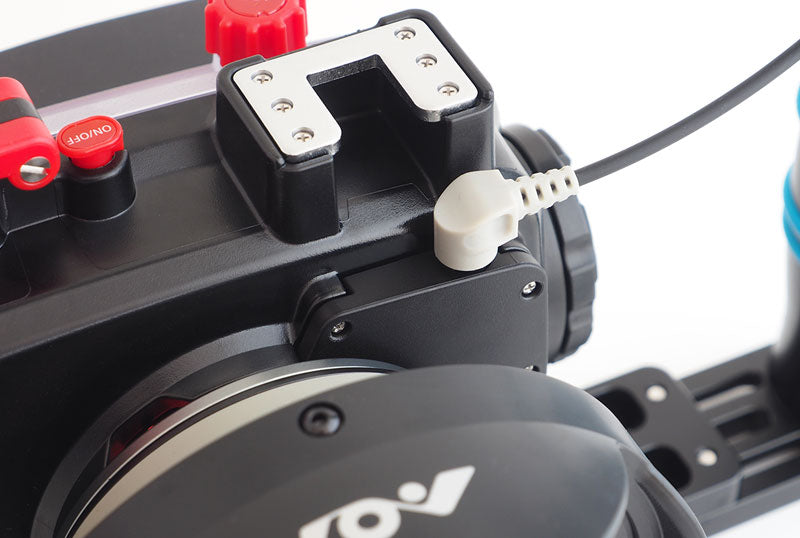
Special Flash sync plate is often needed with the PT-059 housing
Final Words (of Warning)
With a wide-angle lens and a strobe added, the TG-7 dive package is a near-perfect, compact, underwater camera set-up; it's waterproof, lightweight, has tons of advanced functions, comes with an easy-to-use underwater housing and can control external flashes. It does have two downsides, though, that should be taken into consideration before committing.
Firstly, the camera sensor is small and somewhat outdated as almost all compact cameras today (and very soon also phones) come with a bigger 1" sensor. This means that the image quality, especially in low light, could be better, although totally acceptable for most hobby use.
The second downside is the lack of a real aperture. This issue has plagued the Tough camera range since its inception. The lack of an actual lens aperture diaphragm means certain "advanced" shots are impossible. If you want wide-angle shots with beautiful dark blue backgrounds and controlled sunspots while using strobes to highlight the foreground, then the TG-7 is not a camera for you. In these, often near the surface, mixed light situations, a camera with a real aperture is a must.
As long as you use the TG-7 within its limits, it is an excellent underwater camera set-up. It's brilliant for macro, especially when combined with an external strobe. With an added super wide-angle lens, it is also great with scenery shots and bigger things. Even decent close-focus wide-angle is possible with the lens and the light together. Just remember to stay close and get even closer.
See the TG-7 starter package at Mike's Dive Cameras HERE
Subscribe
Sign up to get the latest on sales, new releases and more …
